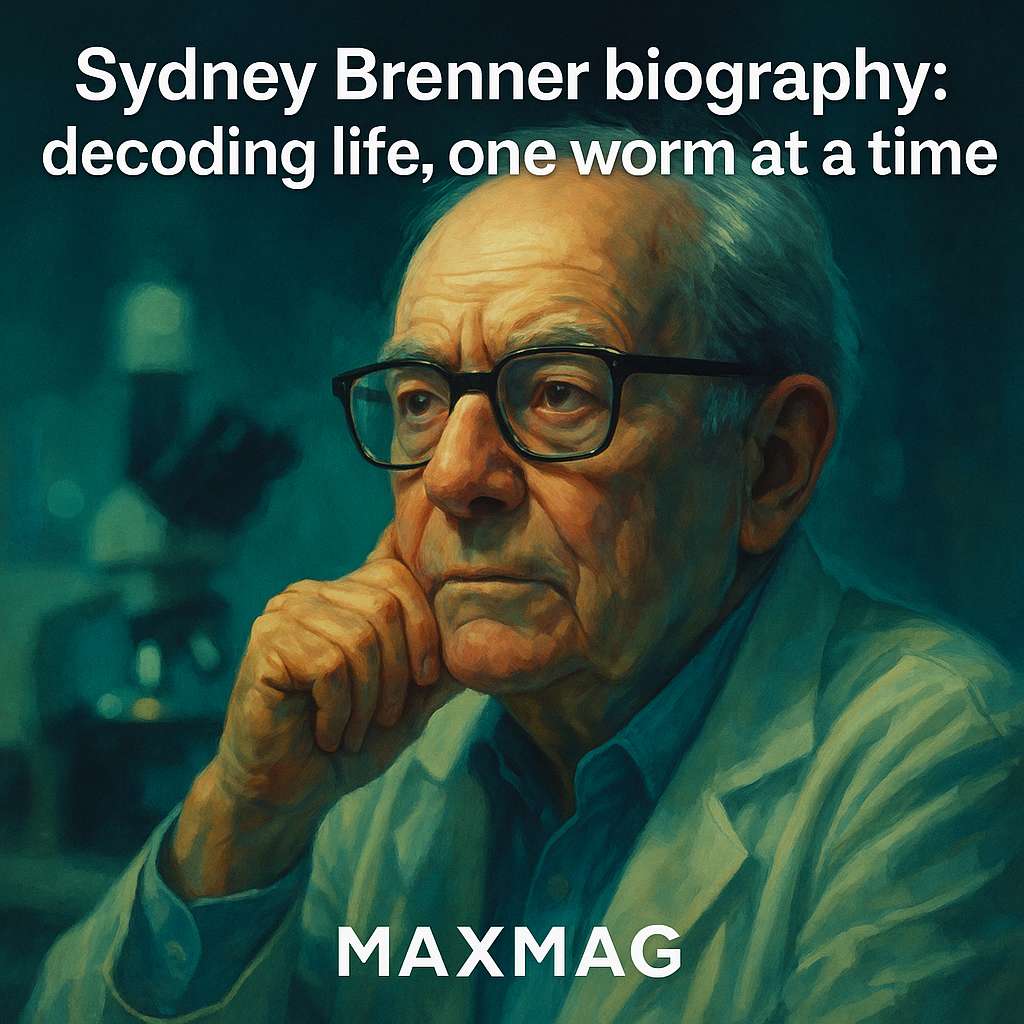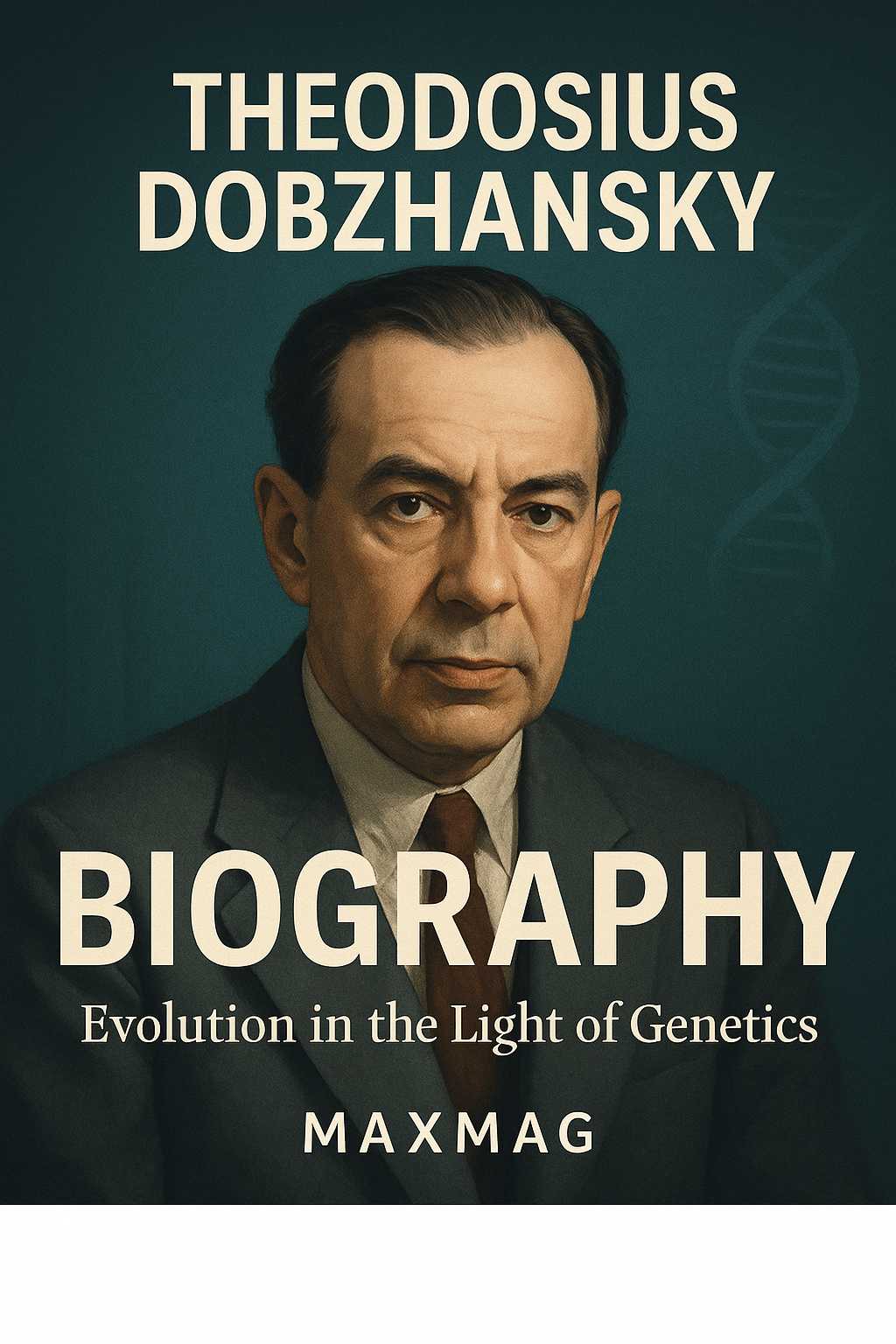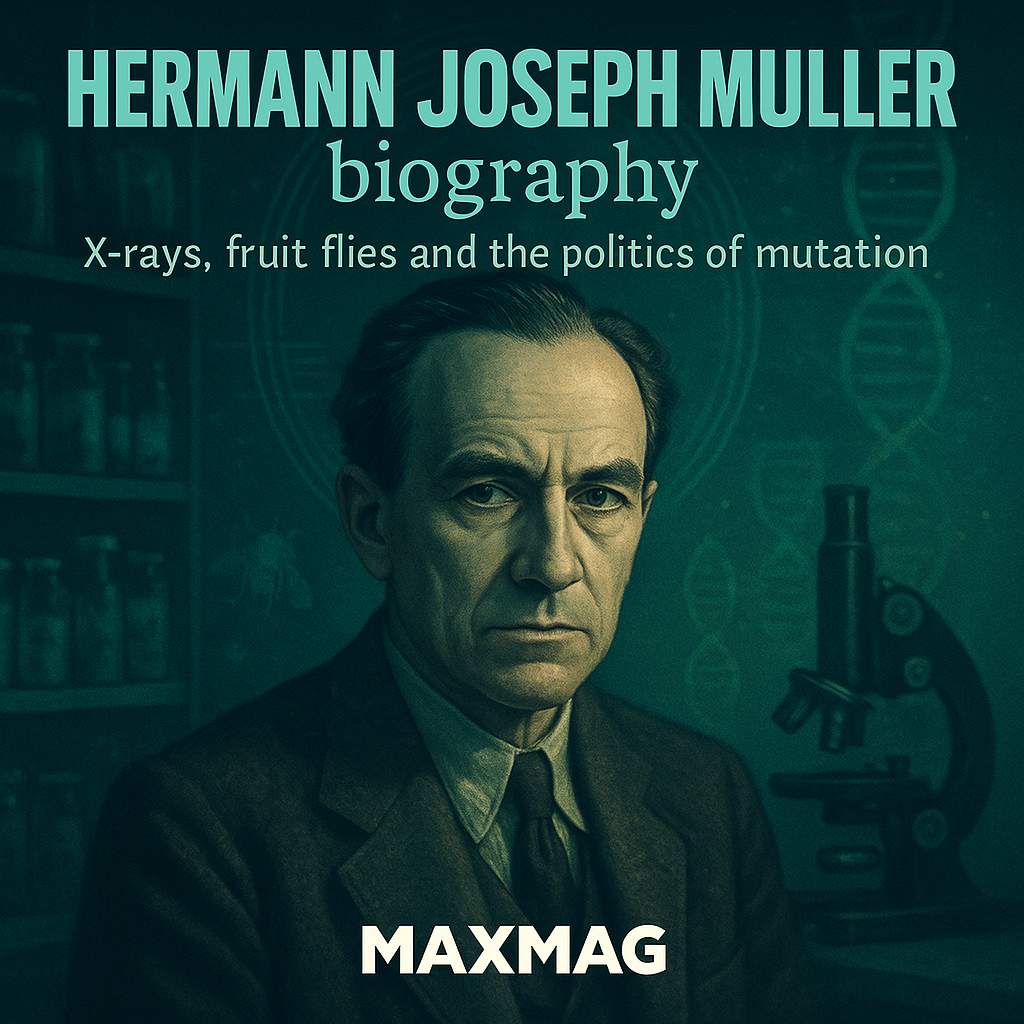
At first glance, the Hermann Joseph Muller biography reads like the story of a man obsessed with tiny flies and invisible rays. Look closer and it becomes something bigger: a tale about how science, politics and conscience collide. Muller, the New York–born geneticist who showed that X-rays can change genes, won a Nobel Prize and spent the rest of his life warning the world about the hidden dangers of radiation. His life traces the arc of twentieth-century science, from crowded student labs in Manhattan to Soviet institutes, Edinburgh lecture halls and, finally, a quiet house in Bloomington, Indiana.
He was not the most famous name of his era, but the stakes of his work could hardly have been higher. The mutations he induced in fruit flies helped explain how heredity works and, by extension, how species change. They also raised unsettling questions: if radiation can scramble the genes of flies, what does it do to human beings, to future generations, to the very fabric of the human gene pool? To understand those questions, and why they still matter today, you have to follow the twists and turns of this complex, sometimes uncomfortable, Hermann Joseph Muller biography.
Hermann Joseph Muller at a glance
- American geneticist (1890–1967), born in New York City and educated at Columbia University.
- Pioneer of radiation genetics; showed that X-rays can induce gene mutations in fruit flies.
- Nobel Prize in Physiology or Medicine in 1946 for the genetic effects of X-rays.
- Outspoken on eugenics, socialism, nuclear weapons and the ethics of science.
- Spent key periods in Texas, Germany, the Soviet Union, Scotland and Indiana, often moving because of politics as much as science.
- Left a lasting mark on genetics, radiation safety debates and the way scientists think about their social responsibilities.
Early Life and Education in the Hermann Joseph Muller biography
New York childhood that shapes the Hermann Joseph Muller biography
Hermann Joseph Muller was born in 1890 on Manhattan’s Upper West Side, the son of a metalworker and a mother from a mixed Jewish and Anglican background. New York at the time was noisy, crowded and feverishly modern – a place where electricity, skyscrapers and immigration were remaking daily life. In this swirl, young Muller found his refuge in books and school laboratories. He was a gifted student in the public school system, the sort of teenager who read science journals for fun and argued about evolution in church youth groups. By his mid-teens he had drifted from Unitarian services into atheism, but kept a kind of secular reverence for nature that would run through the whole Hermann Joseph Muller biography.
Columbia College and a genetics pioneer in the making
At sixteen, Muller entered Columbia College, then emerging as a powerhouse of American biology. In lecture halls dominated by figures like E. B. Wilson, he absorbed the new Mendelian view of heredity: that traits are carried by discrete units — genes — shuttled around on chromosomes. He wasn’t content to just take notes. Muller founded a biology club, debated the social implications of heredity, and became an early enthusiast for using genetics to understand evolution. The club would prove fateful: among the students who joined were Alfred Sturtevant and Calvin Bridges, names that later became central to the famous “fly room” of Thomas Hunt Morgan. Through them, Muller was drawn into the strange little universe of Drosophila melanogaster, the fruit fly that would anchor so much of his work.
The young scientist brought something unusual to Morgan’s group. Many of his colleagues were brilliant experimentalists; Muller, by contrast, had a mind tuned to theory and big patterns. He devised explanations for experimental puzzles and imagined new experiments before anyone had cleared bench space to run them. But the culture of the lab rewarded data, not ideas. When major papers went out without his name attached, Muller felt deeply slighted, a wound that surfaces again and again in the Hermann Joseph Muller biography. That frustration helped drive him away from Columbia and into a peripatetic career that touched universities across the United States and Europe.
Hermann Joseph Muller biography and the Birth of His Big Ideas
The fly room, mutation theory and a restless mind
After a short stint at the newly founded Rice Institute in Texas, where he hurried to complete his PhD so he could take up a teaching post, Muller kept returning — intellectually if not physically — to the problem of mutation. How often do genes change? Are most mutations harmful, neutral or occasionally helpful? In the late 1910s he proposed that many of the dramatic changes seen in plants such as evening primrose could be explained not by mysterious “sports” but by hidden lethal mutations that only occasionally surfaced; a neat theoretical move that made mutation less magical and more statistical. His view fit with a broader picture of evolution as a slow accumulation of tiny genetic changes, rather than rare leaps.
During these years, the Hermann Joseph Muller biography also reveals a man increasingly preoccupied with the social implications of heredity. He embraced eugenics in its most optimistic, reformist guise: the idea that understanding heredity could help societies design healthier conditions and avoid needless suffering. At the same time, he grew deeply critical of the way eugenics was being deployed to justify racist immigration laws and class prejudice. For Muller, genes were powerful, but they did not excuse injustice; if anything, they made the stakes of injustice even higher, because damage to the gene pool could echo across generations.
Texas years: slow experiments, radical questions
In 1920 Muller accepted a position at the University of Texas in Austin. On paper it was a stable professorship; in practice it was a laboratory for risk. His research there was slow, frustrating work on mutation rates in fruit flies. Each new line of flies demanded careful breeding, counting and statistical analysis. He also began using radium and crude X-ray tubes to bombard the insects with radiation, suspecting that invisible rays might jolt genes into changing. It was dangerous, fiddly science: the same beams that might induce mutations also sterilised the flies or simply killed them outright.
Away from the lab bench, he ran twin studies and other projects that probed the hereditary component of intelligence, all the while grappling with where to draw the line between scientific curiosity and social engineering. Austin was also where he threw himself into left-wing politics, editing an illegal student newspaper and convincing colleagues to dream about a more equal society. The Hermann Joseph Muller biography from this period feels like a collision: precise, painstaking experiments by day, fiery pamphlets and late-night arguments about capitalism and human improvement by night.
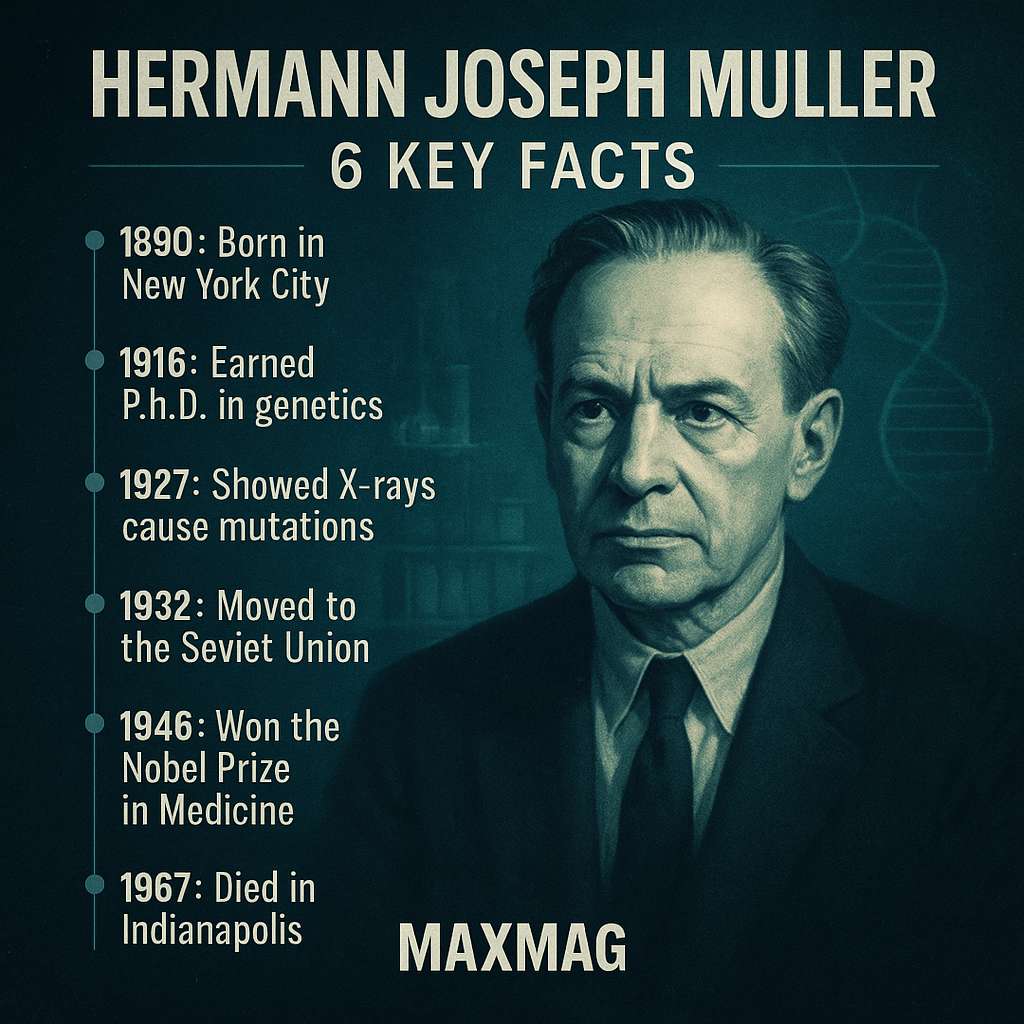
Key Works and Major Contributions of Hermann Joseph Muller
X-ray mutagenesis and “Artificial transmutation of the gene”
The breakthrough Muller had been chasing came in the mid-1920s. Using specially bred fruit flies and careful genetic crosses, he was finally able to separate the lethal effects of radiation from its subtler genetic impact. In November 1926, he ran a series of experiments in which male flies were exposed to different doses of X-rays and then mated with untreated females. The offspring told the story: the more radiation the fathers had received, the more often their descendants died or displayed bizarre traits. In a now-classic paper, “Artificial transmutation of the gene”, he argued that X-rays could directly induce mutations, turning radiation from a vague hazard into a concrete tool — and threat — at the level of DNA.
The impact was immediate. When he presented his findings at the Fifth International Congress of Genetics in Berlin, journalists seized on the idea that scientists could now manufacture mutations at will. Headlines shouted about “tampering with heredity” and “manufacturing new species”. For fellow geneticists, the discovery was less lurid but even more important: it meant they could generate mutations on demand, speeding up the process of mapping genes and testing evolutionary ideas. For anyone reading the Hermann Joseph Muller biography today, it is the hinge moment: the line where a meticulous lab worker becomes an unlikely public figure.
Warning the world about invisible dangers
Muller’s other great contribution was not a single experiment but a decades-long campaign. Long before Hiroshima and Nagasaki, he was writing about the risks of X-rays for physicians, shoe-store clerks and any worker routinely exposed to radiation. After the Second World War, as atmospheric nuclear tests filled the skies with fallout, his warnings grew louder. In his Nobel lecture he argued that there might be no safe threshold: even low doses could, in principle, produce mutations in reproductive cells. He was one of several scientists whose concerns fed into early debates about radiation standards, cancer risks and the ethics of nuclear testing.
Not everyone agreed with his conclusions. Some later geneticists, reviewing new data from mice and human survivors of atomic bombs, argued that Muller had been too alarmist, and that the curve of risk might bend or flatten at very low doses. Others accused him — sometimes unfairly, sometimes with detailed evidence — of ignoring or downplaying studies that contradicted his preferred model. That debate over the linear no-threshold model still surfaces in discussions of environmental regulation today, a reminder that this scientific story is not frozen in time but still shaping policy and public fears.
Methods, Collaborations and Working Style
Basement labs, bottle washers and meticulous notebooks
The practical side of the Hermann Joseph Muller biography is surprisingly earthy. Many of the most important experiments took place in cramped, makeshift laboratories: basement rooms filled with the sweet smell of molasses fly food, benches crowded with glass vials and hand-built X-ray rigs. Muller relied heavily on students and technicians, from bottle washers to aspiring geneticists. He kept elaborate notebooks and insisted on repeated counts, knowing that a single mis-scored fly could skew an entire mutation-rate calculation.
Yet there was also a visionary streak in the way he designed experiments. Long before the structure of DNA was known, he was already describing hereditary material as something that had to be stable yet mutable, capable of self-assembly yet open to random change. Later commentators would note how closely his conceptual sketches matched what Watson and Crick eventually found in the double helix. It is one of the quieter achievements in the Hermann Joseph Muller biography: not just the data he produced, but the way he anticipated what genes would look like physically.
Mentoring a generation of geneticists
Muller was not always the easiest mentor — he could be intense, blunt and impatient — but he attracted talented students. Among those who passed through his orbit were future Nobel laureate George Snell, radiation geneticist Wilson Stone and several scientists who would become influential in Europe and the United States. At Indiana University, where the biology department still honours him with named lectures, his lab became a kind of crossroads for young researchers fascinated by mutation, radiation and evolution. For them, the Hermann Joseph Muller biography was not a finished story but a work in progress they were helping to write.
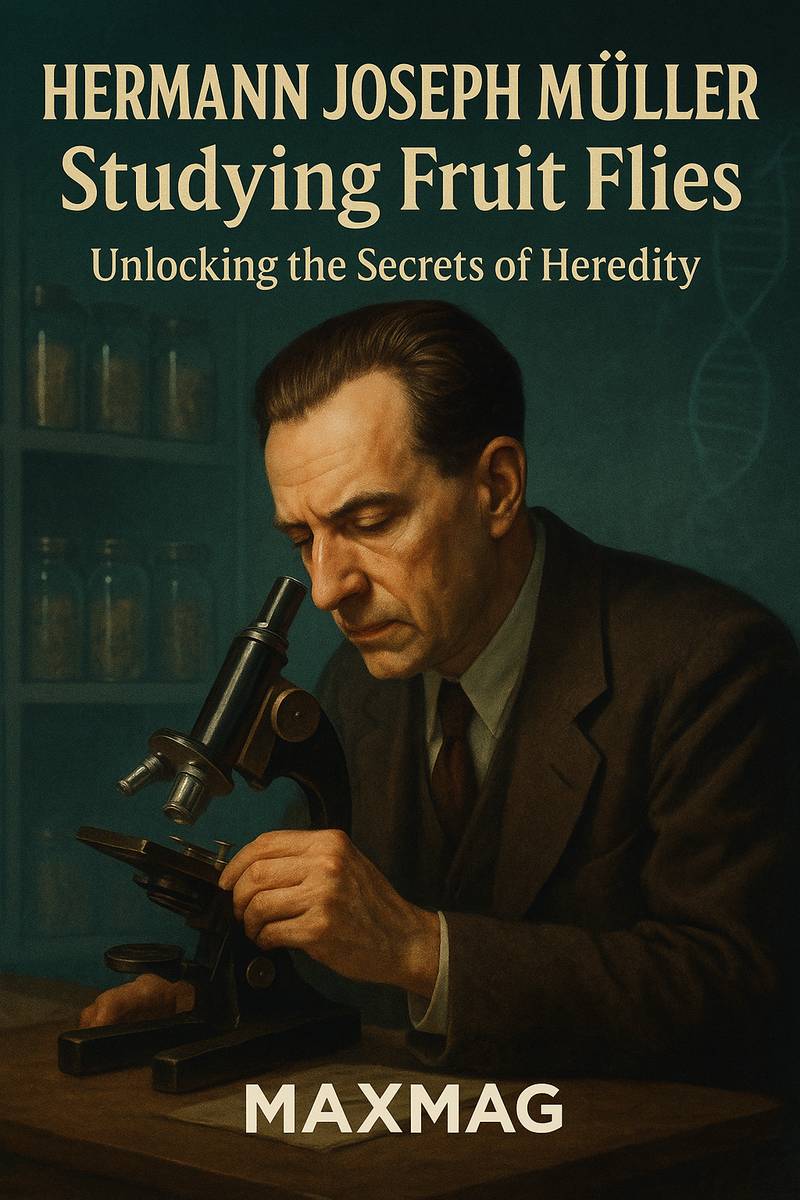
Controversies, Criticism and Misconceptions
Eugenics, idealism and disillusion
One of the more uncomfortable chapters in the Hermann Joseph Muller biography concerns eugenics. Like many scientists of his generation, he initially embraced the idea that better knowledge of heredity could guide social policy. He talked about “improving” the human stock and even entertained futuristic schemes involving donor insemination and long-term planning of reproduction. But he also broke sharply with mainstream American eugenicists on race, class and immigration. His speeches and writings stressed that poverty, slums and lack of education could ruin any gene pool, no matter how “good” the starting material.
Over time, the horror of Nazi racial policies and the growing recognition of environmental influence pushed him further away from early eugenic rhetoric. By mid-century, when he wrote his “Geneticists’ Manifesto” and other public statements, his emphasis had shifted toward global cooperation, social justice and the dangers of authoritarian control over reproduction. The arc here is messy but important: the Hermann Joseph Muller biography illustrates how even gifted scientists can be swept up in fashionable ideas, and how they can — slowly, incompletely — rethink those ideas in the face of new evidence and moral shock.
The linear no-threshold model and a scientist under scrutiny
Mullers insistence that there is no safe dose of radiation became one of the most controversial parts of his legacy. In his Nobel lecture and subsequent writings, he argued that mutation rates rise in direct proportion to dose, with no threshold below which radiation becomes harmless. Regulatory agencies in the United States and elsewhere eventually embraced some version of this linear no-threshold (LNT) model when setting standards for nuclear workers, medical imaging and environmental clean-up.
Decades later, toxicologists such as Edward Calabrese and others dug back into the history and data, arguing that Muller had selectively cited studies and let ideological commitments shape his conclusions. They claimed that some experiments he downplayed pointed instead to curving dose-response relationships, where low doses might have much smaller effects than the LNT model predicts. Supporters counter that Muller was working with the best tools of his time and that the precautionary approach he favoured was reasonable in the shadow of atmospheric tests. Whatever one makes of the dispute, it adds yet another layer to the Hermann Joseph Muller biography: a man who warned of hidden dangers now accused, in turn, of having exaggerated them.
Impact on Genetics and on Wider Society
From fruit flies to cancer and environmental risk
Scientifically, Muller’s work on induced mutation opened the door to a whole sub-discipline of genetics. Radiation mutagenesis became a standard tool for probing gene function in plants, animals and microbes. The idea that cancer might be driven by accumulated mutations fitted naturally with his findings, and later researchers studying DNA repair, chromosome breaks and tumour formation regularly cited his early papers. In plant breeding, meanwhile, deliberate mutagenesis created new crop varieties, an offshoot he might have regarded with mixed feelings, given his worries about long-term genetic harm.
Socially, the Hermann Joseph Muller biography is intertwined with the rise of the nuclear age. His warnings about fallout contributed to a growing public suspicion of nuclear testing, helping to build the pressure that produced partial test-ban treaties. He signed the Russell–Einstein Manifesto and supported the Pugwash Conferences, which brought scientists together across Cold War lines to discuss nuclear dangers. His authority as a Nobel-winning geneticist lent weight to campaigns that extended far beyond the lab.
A voice in the nuclear age
Muller was not a lone prophet — many physicists, doctors and activists raised similar concerns — but he occupied a distinctive niche. Where others spoke about immediate burns, cancers and battlefield horrors, he insisted on the slow, generational damage that might never show up in a headline. To understand his influence, it helps to read both his scientific work and popular accounts, as well as later analyses in outlets such as a Washington Post discussion of Soviet genetics and its protagonists, where his name surfaces in a wider story about politics and heredity. In that sense, the Hermann Joseph Muller biography is a bridge between lab-bench detail and geopolitical anxiety.
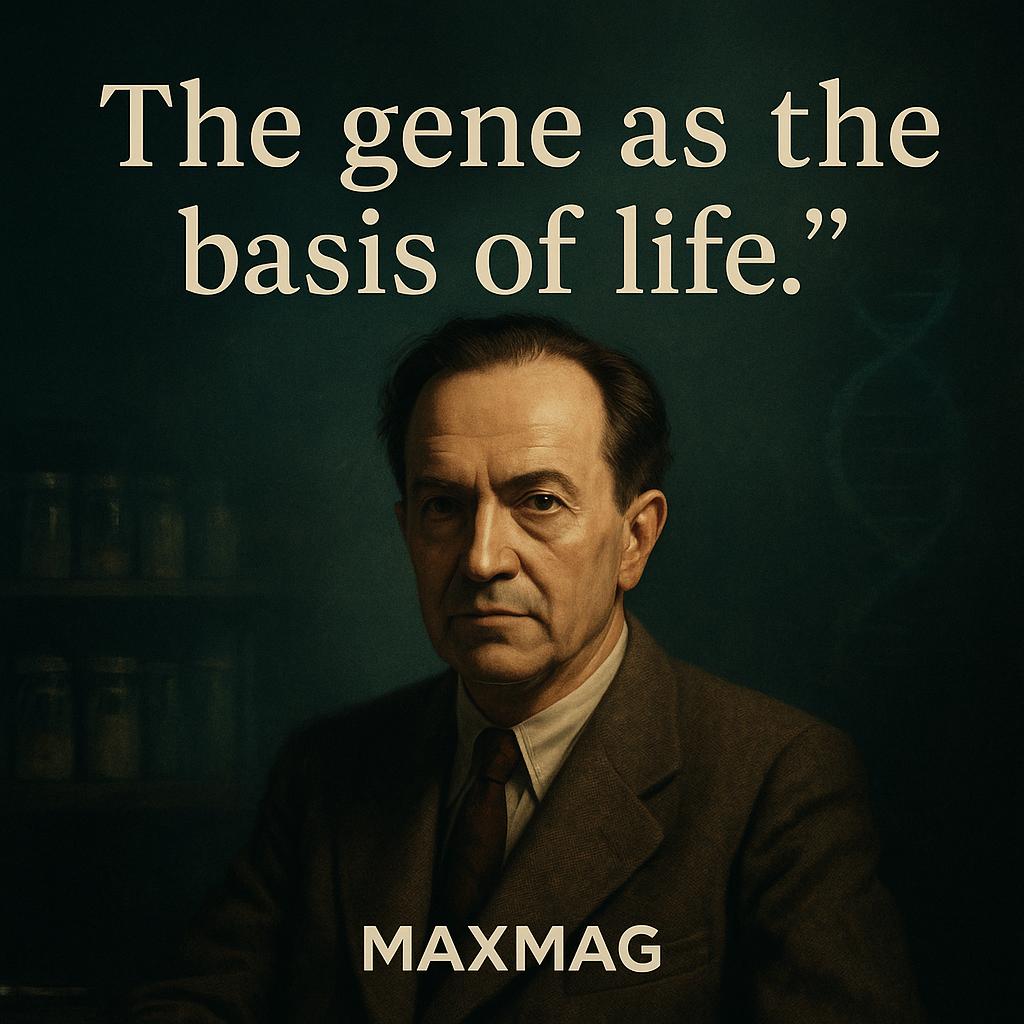
Personal Beliefs, Character and Private Life
Politics, exile and humanism
The mid-1930s plunged Muller into one of the most dramatic phases of his life. Disillusioned with conditions in Texas and attracted by socialism, he moved to Berlin and then to the Soviet Union, hoping to help build a society that took science seriously. He set up a major genetics lab in Leningrad and later Moscow, bringing in hundreds of strains of fruit flies and training young Soviet geneticists. For a time, it looked like a new golden age. Then politics intervened. Stalinist ideology, embodied in the agronomist Trofim Lysenko, turned against Mendelian genetics; Muller’s work was denounced, and he quietly arranged to leave before the purges grew even worse.
This period, when read as part of the Hermann Joseph Muller biography, reveals a man repeatedly buffeted by history. His FBI file back in the United States, his difficult search for jobs during the Red Scare, and his bitter memories of ideological interference in the Soviet Union all deepened his commitment to scientific autonomy and internationalism. Later, as president of the American Humanist Association, he argued publicly for a worldview grounded in reason, empathy and a long-term view of humanity’s future — an ethic clearly shaped by the brutal politics he had witnessed.
Family ties and private burdens
Behind the public persona, the Hermann Joseph Muller biographyalso includes a complicated family life. He married twice, first to mathematician Jessie Jacobs and later to Dorothea Kantorowicz, a German Jewish refugee. Both marriages were strained at times by his moves across continents and by his consuming focus on work and politics. His children, including future academic Helen Muller and mathematician David Muller, grew up in the shadow of a father whose name was known in scientific circles but who often seemed preoccupied or absent.
Friends and students remembered him as intense, principled and sometimes prickly — a man who could be generous with his time one moment and cutting the next. He worried about money, job security and the fate of the world, yet could be playful when showing a student how to anaesthetise flies or pick out a rare mutant under the microscope. These human details stop the Hermann Joseph Muller biography from becoming a simple story of triumph or controversy; they show a scientist struggling, like anyone else, to balance ideals with the demands of ordinary life.
Later Years and Final Chapter of Hermann Joseph Muller
Indiana University, the Nobel Prize and a changing discipline
After short periods at Edinburgh and Amherst College, Muller finally found something like a permanent home at Indiana University in Bloomington in the mid-1940s. There, as professor of zoology, he built a thriving research and teaching programme just as genetics was transforming into a central pillar of biology. When the Nobel Committee recognised his X-ray work in 1946, the award instantly elevated both him and the institution. Indiana still commemorates him with an annual named lecture, using the university’s own biographical sketch of Muller to introduce new generations to his story.
In Bloomington, the older Muller continued to publish on spontaneous mutation rates, radiation risks and evolutionary theory. He also became a local character: the Nobel laureate who could be seen walking to campus from his Vinegar Hill neighbourhood, sometimes lost in thought, sometimes ready to launch into an impromptu lecture about genes and the future of humanity. Even as molecular biology surged ahead, with DNA structure and genetic code deciphered by younger scientists, he remained convinced that population-level thinking about mutation and selection was essential.
Closing years of a restless mind
Muller officially retired in 1964 but kept writing and corresponding until his death in 1967. The last pages of the Hermann Joseph Muller biography do not end in dramatic revelation; instead, they show a man still wrestling with questions he had been asking since his student days. How much of who we are is written in our genes? What responsibility do we have to future generations? And how can science guide politics without becoming its servant?
By then, former students had spread around the world, carrying his influence into new areas of genetics, immunology and evolutionary biology. The chromosomal “Muller elements” in fruit flies, the continuing debates about radiation standards, and the ongoing fascination with induced mutation all ensure that his name has not vanished from textbooks. Yet the full Hermann Joseph Muller biography — with its mix of brilliance, stubbornness, idealism and controversy — is richer and more instructive than any single concept or experiment attached to it.
The Lasting Legacy of the Hermann Joseph Muller biography
Why the Hermann Joseph Muller biography still matters
In an era of CRISPR gene editing, genomic surveillance and heated arguments about “designer babies”, the Hermann Joseph Muller biography feels uncannily current. His life reminds us that new technologies of heredity always arrive entwined with dreams and fears: dreams of curing disease and improving lives, fears of abuse, inequality and unforeseen harm. Muller understood both sides. His X-ray experiments expanded the tools of genetics immeasurably, yet he spent much of his career warning about the misuse of those tools.
His story also shows how scientific authority can be both powerful and fragile. A Nobel Prize allowed him to speak loudly in public debates, but it did not shield his ideas from later criticism. The arguments over his radiation models are a useful caution against treating any scientist, however accomplished, as beyond scrutiny. In that sense, grappling honestly with the Hermann Joseph Muller biography — its achievements, blind spots and revisions — helps us think more clearly about today’s controversies, from nuclear power to chemical safety.
Finally, Muller’s life offers a broader lesson about science as a human enterprise. It is not just a sequence of experiments, but a web of institutions, ideologies and personalities. Understanding the Hermann Joseph Muller biography means seeing how a clever, stubborn New Yorker navigated that web — sometimes brilliantly, sometimes imperfectly — and how his choices still echo in the genetic and environmental debates shaping the twenty-first century.
Frequently Asked Questions about Hermann Joseph Muller biography
Q1: Who was Hermann Joseph Muller and why is his biography important to genetics?
Q2: What was Muller's most significant scientific contribution?
Q3: How did the Hermann Joseph Muller biography intersect with politics and ideology?
Q4: Why is there controversy around Muller's views on radiation safety?
Q5: How did Muller influence later generations of scientists?
Q6: What can we learn today from the Hermann Joseph Muller biography?





